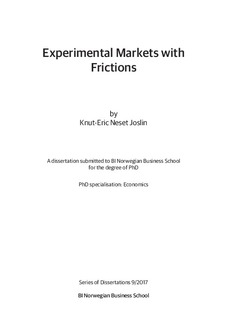Experimental Markets with Frictions
Abstract
Included in this dissertation are four articles: (1) Market Entry with Frictional Matching and Bargaining: Labor Search in the Lab (2) Discrimination in Small Markets with Directed Search: Part I Theory (3) Discrimination in Small Markets with Directed Search: Part II Experiment and (4) Should I Stay or Should I Go: Bandwagons in the Lab. The first paper, Market Entry with Frictional Matching and Bargaining: Labor Search in the Lab, tests elements from the standard labor search model using a modified market entry game that includes labor market features. We reproduce key comparative statics in the lab and conclude that the no-profit condition at the heart of the standard labor search model is nearly satisfied. This is an important result for the credibility of the model. The one deviation that we observe is that vacancy creation does not respond quite as strongly to the level of productivity as predicted.
The second two papers are part of a single project, Discrimination in Small Markets with Directed Search. This project investigates how discriminatory hiring impacts the blackwhite wage gap in markets with directed search. The first paper develops the theory while the second paper takes a simple version of the model to the lab. Although we find that search behavior in this setting aligns well with theory, the anticipated discrimination effect is not as strong as predicted by the model. Nevertheless, the study does substantiate a segregation effect. Relative to the case without discrimination, more firms offer low wages and discriminated workers earn lower income.
The last paper included in the dissertation, Should I Stay or Should I Go: Bandwagons in the Lab, is co-authored with Leif Helland and Tom-Reiel Heggedal. This project tests a seminal model of platform coordination. We find that the equilibrium of the model effectively predicts behavior. When we in addition allow for some noise in the equilibrium concept, the model matches observation closely.
